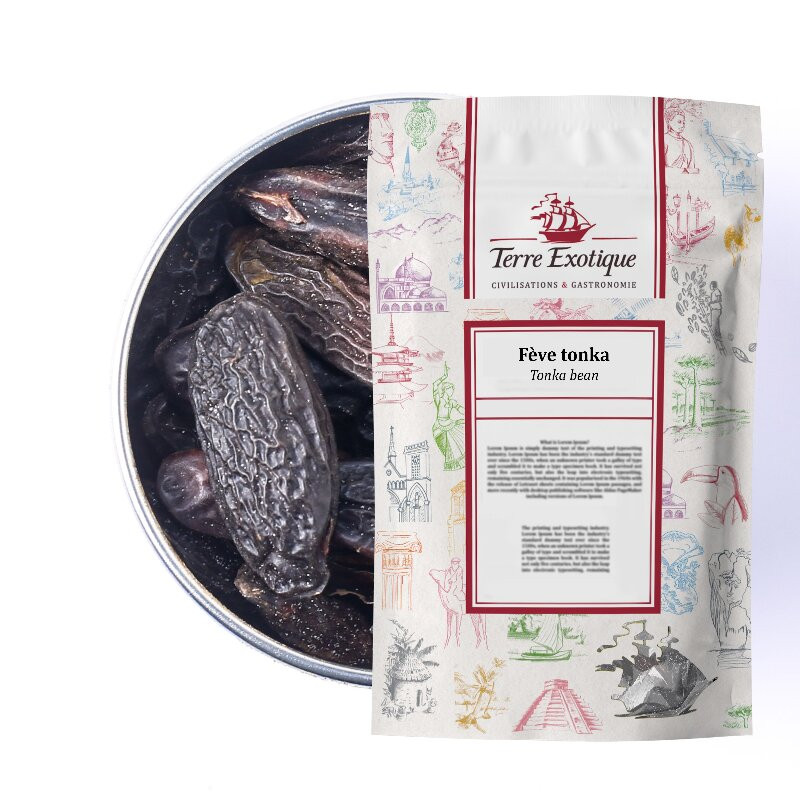- New

Order by 4 pm = delivery the next working day.
From CHF 100 purchase



The tonka bean selected by Terre Exotique will enrich your sweet and savory recipes thanks to its Amazonian fragrance.
The tonka bean, a beautiful plant from the Amazon region, has a warm, delicious scent between vanilla and caramel. Grated or infused, it lends a warming character to desserts, fish, vegetables, shellfish and white meat.
Data sheet
Almond, caramel or tobacco: the beguiling aromas of the tonka bean are as versatile as the bean's field of application. Depending on where it is grown and how it is cared for, it has aromas of sweet almonds, vanilla, caramel and even coffee. Its round and warm taste is incredibly fine, with a slight bitterness reminiscent of cocoa. The tonka bean from Terre Exotique is very mild and hardly spicy, so it goes well with various creations without being too dominant.
The tonka bean is used grated in compotes, creamy desserts, with chocolate, in pumpkin soup or with sweet potatoes. However, be careful not to use too much tonka bean! It contains coumarin, a substance that gives it a strong aroma but also forms the natural defenses of the tree that bears its fruit... In addition, the flavor of the tonka bean intensifies about tenfold when it cools down. Grate them, like nutmeg, in a fine grinder or on a fine vegetable grater.
Surprise your guests with an unusual and warm taste in a wide variety of dishes. To do this, rub some tonka bean over
- a chocolate mousse
- a dark chocolate cake
- a compote of apples and pears
- a pumpkin soup
- sweet potato puree
- veal medallions in a cream sauce
- fried prawns
The tonka bean grows in the tropical climate and dense forest of the Amazon region. It is found in the heart of the fruits of trees of the Fabaceae family, more precisely the Dipteryx Odorata. These gigantic trees, also known as "coumarou", can grow up to 30 meters high and tower over the canopy of the jungle. They thrive in a warm tropical climate and on humus-rich, very fertile soil. These giants produce orange-colored fruits that are shaped like a mango. The tonka bean is the core of this fruit.
The coumarou produces its fruit every year and lets it fall to the ground when it is ripe. The fruits are then collected and dried for almost a year. After this ripening period, the fruit is broken open to expose the bean in the center. The seeds are then soaked in strong alcohol for a day. After this long process, they are dried again, turning black and wrinkled, no larger than 3 cm.
Terre Exotique tonka beans are produced in Brazil, where villagers and locals share the harvest. There, the tonka bean, also known as "cumaru", is used for its healing effect on the bronchi and lungs through local application or ingestion. It is also used to make candles and incense. Its culinary use, as we appreciate it, is hardly used in its country of origin.
Before its use in cooking, the tonka bean was primarily an ally of Western perfumers and tobacco manufacturers. Its sweet scent, reminiscent of vanilla and hay, was used to flavor blond tobacco. In the world of cosmetics, it is still one of the main ingredients of many perfumes. It has a special connection with the House of Guerlain®, which has been using it in its fragrances since the end of the 19th century.
| Energiewert in kJ | 2197 kJ |
| Energiewert in kcal | 525 kcal |
| Fett | 36.30 g |
| davon gesättigte Fettsäuren | 25.90 g |
| Protein/ Eiweiss | 5.80 g |
| Salz | 0.01 g |
| Kohlenhydrate | 49.30 g |
| davon Zucker | 28.50 g |
Allergens

The tonka bean selected by Terre Exotique will enrich your sweet and savory recipes thanks to its Amazonian fragrance.
The tonka bean, a beautiful plant from the Amazon region, has a warm, delicious scent between vanilla and caramel. Grated or infused, it lends a warming character to desserts, fish, vegetables, shellfish and white meat.